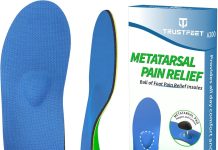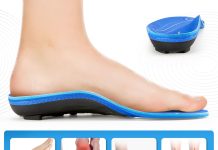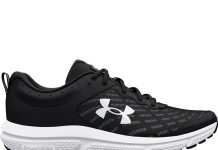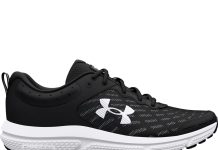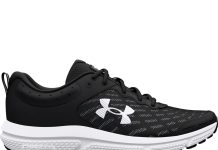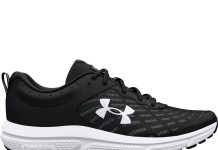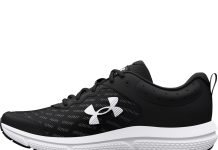Are you seeking the perfect pair of shoes for your power walking routine? If you’re wondering whether running shoes can do the trick, we’ve got you covered. In this article, we’ll explore whether running shoes can be suitable for power walking. We’ll discuss the key similarities and differences between these two types of footwear and provide the information you need to make an informed decision. So, lace up your sneakers, and let’s get walking!
The Differences Between Running Shoes and Walking Shoes
Regarding footwear, there are significant differences between running shoes and walking shoes. These differences are primarily related to cushioning and support, flexibility, weight, and heel-to-toe drop. Understanding these distinctions will help us determine the best shoes for power walking.
Cushioning and Support
Running shoes are designed to provide ample cushioning and support to protect the feet and joints from the impact caused by running. They often have additional padding in the midsole and heel to absorb shock and enhance stability. On the other hand, walking shoes have less cushioning and support since walking is a low-impact activity that doesn’t require as much shock absorption.
Flexibility
Flexibility plays a crucial role in the performance of our shoes. Running shoes are designed to be more flexible to accommodate the foot’s natural movement during the running stride. They often feature grooves and flex points in the sole, allowing a smooth transition from heel strike to toe-off. Walking shoes, on the other hand, tend to have stiffer soles to provide better stability and support while walking.
Weight
The weight of the shoes can significantly impact our comfort and performance. Running shoes are generally lighter than walking shoes since runners require footwear that allows for quick and efficient movement. Lighter shoes help to reduce fatigue and increase speed. On the other hand, walking shoes are typically heavier to provide additional stability and support for the slower pace of walking.
Heel-to-Toe Drop
Heel-to-toe drop, also known as the offset, refers to the difference in height between the heel and the shoe’s forefoot. Running shoes often have a higher heel-to-toe drop to promote forward momentum and encourage efficient running form. On the other hand, walking shoes tend to have a more minimal drop to provide a more natural and comfortable walking stride.
Benefits of Using Running Shoes for Power Walking
Using running shoes for power walking offers several benefits that enhance our overall experience and performance. Let’s explore these benefits in more detail.
Versatility
One of the main advantages of using running shoes for power walking is their versatility. Running shoes are designed to accommodate various foot types and walking styles. They offer a balance of cushioning, support, and flexibility that caters to various walking surfaces and terrains. Whether we prefer walking on the pavement, track, or trail, running shoes can handle it all.
Comfort
Thanks to their extensive cushioning and supportive features, running shoes are known for their comfort. This makes them ideal for power walking, as they provide a plush and comfortable fit. The added cushioning in the midsole and heel helps to absorb shock and reduce the risk of discomfort or injury during long walks.
Durability
Running shoes are designed to withstand the rigors of regular running, which means they are built to be durable. They are constructed with sturdy materials and reinforced soles to ensure long-lasting performance. This durability makes running shoes an excellent option for power walking, where we put our shoes through frequent use and wear.
Considerations When Using Running Shoes for Power Walking
While running shoes can be suitable for power walking, there are a few essential considerations to consider to optimize our walking experience and reduce the risk of injury.
Stride Length
When power walking, it’s essential to maintain an appropriate stride length. Since running shoes are designed for a longer stride length during running, we may need to make adjustments when power walking. Taking shorter, quicker steps can help us maintain proper form and minimize stress on our muscles and joints.
Foot Strike Pattern
Proper foot strike is crucial to prevent injuries and ensure an efficient power walking gait. The foot strike pattern differs between running and walking. When power walking, we typically land on our heels or midfoot rather than the forefoot, which is common in running. Selecting running shoes that offer adequate cushioning and support for the specific foot strike pattern of power walking is essential.
Surface Terrain
Power walking can take us on various surfaces, including pavement, trails, and uneven terrain. It’s essential to consider the terrain we will encounter and choose running shoes that provide the appropriate traction and stability for those surfaces. Shoes with lugs or a more aggressive outsole tread pattern may benefit off-road power walking, while shoes with a smoother outsole may be more suitable for paved surfaces.
Pronation
Pronation is the natural inward rolling motion of the foot during walking or running. Understanding our pronation type can help us select the right running shoes for power walking. Overpronation, where the foot rolls excessively inward, may require shoes with motion control or stability features to correct the foot’s alignment. Underpronation (supination), where the foot rolls outward, may benefit from neutral or cushioned shoes to provide proper support and shock absorption.
Arch Support
The level of arch support required varies among individuals. Some power walkers with high arches may benefit from shoes with additional arch support to maintain proper foot alignment and prevent discomfort. Others with flatter arches may find shoes with a more neutral arch to provide better comfort and support. Understanding our foot type and selecting running shoes that accommodate our arches is essential for optimal power walking performance.
Choosing the Right Running Shoes for Power Walking
Several factors should be considered when choosing running shoes for power walking to ensure a comfortable and enjoyable experience.
Cushioning Level
The cushioning level of running shoes is vital in comfort and impact absorption. Power walkers may prefer shoes with moderate to high levels of cushioning to provide a plush and comfortable feel during long walks. However, striking a balance is essential, as excessive cushioning may affect stability and natural foot movement.
Stability vs. Neutral Shoes
Running shoes come in various stability levels, from stability to neutral shoes. Stability shoes are designed to provide additional support and control for overpronation, making them suitable for power walkers with this pronation type. Neutral shoes, on the other hand, offer a more natural and flexible feel for those with neutral or underpronation. Selecting the appropriate level of stability based on our pronation type is crucial for a comfortable and supported power walking experience.
Toe Box Room
Enough room in the toe box is essential for comfort and preventing issues like blisters or black toenails. Power walkers should look for running shoes with ample toe box room for natural foot splay during each step. Shoes that are too narrow or restrictive in the toe area can cause discomfort and lead to foot problems over time.
Breathability
Power walking often leads to increased foot perspiration. Choosing running shoes with breathable materials and mesh panels allows for better air circulation and moisture-wicking, keeping our feet cool and dry. Shoes with good breathability also help prevent odor and bacterial growth, ensuring a fresh and hygienic walking experience.
Outsole Grip
The outsole grip is crucial for power walkers as it determines traction and stability on various surfaces. Look for running shoes with a durable, grippy outsole that provides reliable traction in wet and dry conditions. This will help prevent slips and falls, especially when walking on slippery surfaces or loose terrain.
Taking Care of Your Running Shoes for Power Walking
Proper care and maintenance are essential to ensure the longevity and performance of our running shoes for power walking. Here are some tips to help us keep our shoes in top condition:
Cleaning
Regular cleaning is necessary to remove dirt, mud, and sweat from our shoes. We can use a mild detergent or shoe cleaner and a soft brush to gently scrub any dirt on the upper, midsole, and outsole. After cleaning, allow the shoes to air dry naturally, away from direct sunlight or heat sources.
Replacing Worn-out Shoes
Running shoes, like any footwear, eventually wear out over time. It’s essential to monitor the condition of our shoes and replace them when necessary. Generally, running shoes should be replaced every 300-500 miles or when the treads on the outsole become worn down. Using worn-out shoes can lead to discomfort, reduced support, and increased risk of injury.
Rotating Shoes
Rotating between multiple pairs of running shoes can prolong their lifespan and prevent excessive wear. Alternating between shoes allows each pair to fully dry and decompress between uses, reducing odor and extending the overall durability. It’s also beneficial to have different running shoes for various workouts or terrains, providing us with flexibility and versatility.
Tips for Optimal Power Walking Performance
To make the most of our power walking sessions, here are some tips to enhance our performance and achieve maximum benefits:
Proper Warm-Up
Before starting a power walking session, it’s crucial to warm up properly. Engaging in dynamic stretching exercises, such as leg swings and walking lunges, helps to prepare the muscles and joints for the activity. Warming up increases blood flow, enhances flexibility, and reduces the risk of injury.
Maintaining Good Posture
Maintaining good posture throughout the power walking session is essential for proper alignment and efficient movement. Stand tall, engage the core muscles, and keep the shoulders relaxed. Avoid leaning forward or slouching, as this can cause unnecessary strain on the back and neck.
Maintaining a Consistent Pace
Maintaining a consistent pace allows for a steady and practical power-walking session. Find a comfortable speed that challenges but doesn’t strain you. Focus on maintaining a brisk pace while still being able to carry on a conversation. Consistency helps build endurance and improve cardiovascular fitness over time.
Cooling Down and Stretching
After completing a power walking session, it’s essential to cool down gradually to allow the body to transition back to its resting state. Slow the pace and perform gentle stretches to help lengthen and relax the muscles.
Common FAQs About Using Running Shoes for Power Walking
Here are some frequently asked questions about using running shoes for power walking:
Can I use trail running shoes for power walking?
Trail running shoes can be suitable for power walking, mainly if our walks include off-road or uneven terrain. Trail running shoes are designed to provide better traction, stability, and protection on rugged surfaces. These shoes often feature a more aggressive outsole tread pattern and additional protection in the upper to handle various trail conditions.
Should I size up or down in running shoes for power walking?
It is generally recommended to go up half a size when purchasing running shoes for power walking. Power walking can cause the feet to swell slightly, especially during longer walks. Sizing up allows extra room to accommodate this swelling and prevents discomfort or constriction.
Can I use minimalist running shoes for power walking?
Using minimalist running shoes for power walking is possible but may not be suitable for everyone. Minimalist shoes have a thin sole and minimal cushioning, allowing for a more natural foot movement and sensory feedback. They can help strengthen the feet and lower legs but may not provide enough cushioning and support for extended power walking sessions or walkers requiring extra stability.
Conclusion
Choosing the right shoes for power walking can significantly enhance our experience and performance. While running shoes can be a suitable option, it’s essential to consider factors like cushioning, support, flexibility, and our specific walking needs.
Understanding our pronation, stride length, foot strike pattern, and terrain requirements will also help guide our shoe selection. By taking care of our running shoes and following proper power walking techniques, we can enjoy the benefits of this low-impact exercise while maintaining foot comfort and overall well-being.
So, lace up your shoes, hit the pavement or trail, and enjoy the power of walking!


